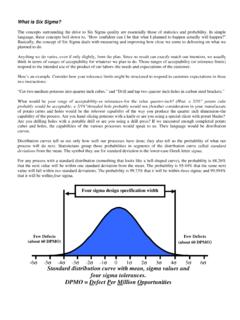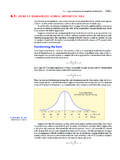Transcription of Statistics Ch 6 Exam Review Using the following uniform ...
1 Statistics Ch 6 Exam Review Name_____. MULTIPLE CHOICE. Choose the one alternative that best completes the statement or answers the question. Using the following uniform density curve, answer the question. 1) What is the probability that the random variable has a value greater than 5? 1). A) B) C) D) 2) What is the probability that the random variable has a value greater than 2). A) B) C) D) 3) What is the probability that the random variable has a value less than 6? 3). A) B) C) D) 4) What is the probability that the random variable has a value less than 4).
2 A) B) C) D) 5) What is the probability that the random variable has a value between and 5). A) B) C) D) 6) What is the probability that the random variable has a value between and 6). A) B) C) D) Assume that the weight loss for the first month of a diet program varies between 6 pounds and 12 pounds, and is spread evenly over the range of possibilities, so that there is a uniform distribution. Find the probability of the given range of pounds lost. 7) More than 10 pounds 7). 1 5 2 1. A) B) C) D). 3 6 3 7. 8) Less than 11 pounds 8). 1 5 1 5.
3 A) B) C) D). 6 6 3 7. 9) Between 8 pounds and 11 pounds 9). 1 2 1 1. A) B) C) D). 3 3 2 4. 10) Between pounds and 10 pounds 10). 1 1 1 3. A) B) C) D). 2 3 4 4. 1. Find the area of the shaded region. The graph depicts the standard normal distribution with mean 0 and standard deviation 1. 11) 11). z A) B) C) D) 12) 12). z A) B) C) D) 13) 13). z A) B) C) D) 14) 14). z A) B) C) D) 2. 15) 15). z A) B) C) D) 16) 16). z A) B) C) D) 17) 17). z A) B) C) D) 18) 18). z A) B) C) D) Find the indicated z score. The graph depicts the standard normal distribution with mean 0 and standard deviation 1.
4 19) Shaded area is 19). z A) B) C) D) 3. 20) Shaded area is 20). z A) B) C) D) 21) Shaded area is 21). z A) B) C) D) 22) Shaded area is 22). z A) B) C) D) 23) Shaded area is 23). z A) B) C) D) 24) Shaded area is 24). z A) B) C) D) If z is a standard normal variable, find the probability. 25) The probability that z lies between 0 and 25). A) B) C) D) 4. 26) The probability that z lies between and 0 26). A) B) C) D) 27) The probability that z is less than 27). A) B) C) D) 28) The probability that z lies between and 28). A) B) C) D) 29) The probability that z lies between and 29).
5 A) B) C) D) 30) The probability that z lies between and 30). A) B) C) D) 31) The probability that z is greater than 31). A) B) C) D) 32) P(z > ) 32). A) B) C) D) 33) P(z < ) 33). A) B) C) D) 34) P( < z < ) 34). A) B) C) D) Find the indicated z score. The graph depicts the standard normal distribution with mean 0 and standard deviation 1. 35) Shaded area is 35). z A) B) C) D) The Precision Scientific Instrument Company manufactures thermometers that are supposed to give readings of 0 C at the freezing point of water. Tests on a large sample of these thermometers reveal that at the freezing point of water, some give readings below 0 C (denoted by negative numbers) and some give readings above 0 C (denoted by positive numbers).
6 Assume that the mean reading is 0 C and the standard deviation of the readings is C. Also assume that the frequency distribution of errors closely resembles the normal distribution. A thermometer is randomly selected and tested. Find the temperature reading corresponding to the given information. 36) Find P96, the 96th percentile. 36). A) B) C) D) . 37) Find P40, the 40th percentile. 37). A) B) C) D) . 5. 38) Find Q3, the third quartile. 38). A) B) C) D) . 39) If 7% of the thermometers are rejected because they have readings that are too high, but all other 39).
7 Thermometers are acceptable, find the temperature that separates the rejected thermometers from the others. A) B) C) D) . 40) If 9% of the thermometers are rejected because they have readings that are too high, but all other 40). thermometers are acceptable, find the temperature that separates the rejected thermometers from the others. A) B) C) D) . 41) If 7% of the thermometers are rejected because they have readings that are too low, but all other 41). thermometers are acceptable, find the temperature that separates the rejected thermometers from the others.
8 A) B) C) D) . 42) If 9% of the thermometers are rejected because they have readings that are too low, but all other 42). thermometers are acceptable, find the temperature that separates the rejected thermometers from the others. A) B) C) D) . 43) A quality control analyst wants to examine thermometers that give readings in the bottom 4%. 43). Find the reading that separates the bottom 4% from the others. A) B) C) D) . 44) A quality control analyst wants to examine thermometers that give readings in the bottom 7%. 44). Find the reading that separates the bottom 7% from the others.
9 A) B) C) D) . 45) If of the thermometers are rejected because they have readings that are too high and another 45). are rejected because they have readings that are too low, find the two readings that are cutoff values separating the rejected thermometers from the others. A) , B) , C) , D) , . Find the indicated value. 46) 46). A) B) C) D) 47) 47). A) B) C) D) Provide an appropriate response. 48) Which of the following is true about the distribution of IQ scores? 48). A) The standard deviation is 10. B) The mode is 100. C) The mean is 50.
10 D) The mean is 1. 6. 49) Which of the following is true about the distribution of IQ scores? 49). A) The area under its bell -shaped curve is 1. B) The area under its bell -shaped curve is 5. C) It is a standard normal distribution. D) Its distribution is skewed to the left. 50) Find the area of the shaded region. The graph depicts IQ scores of adults, and those scores are 50). normally distributed with a mean of 100 and a standard deviation of 15 (as on the Wechsler test). A) B) C) D) 51) Find the area of the shaded region. The graph depicts IQ scores of adults, and those scores are 51).







